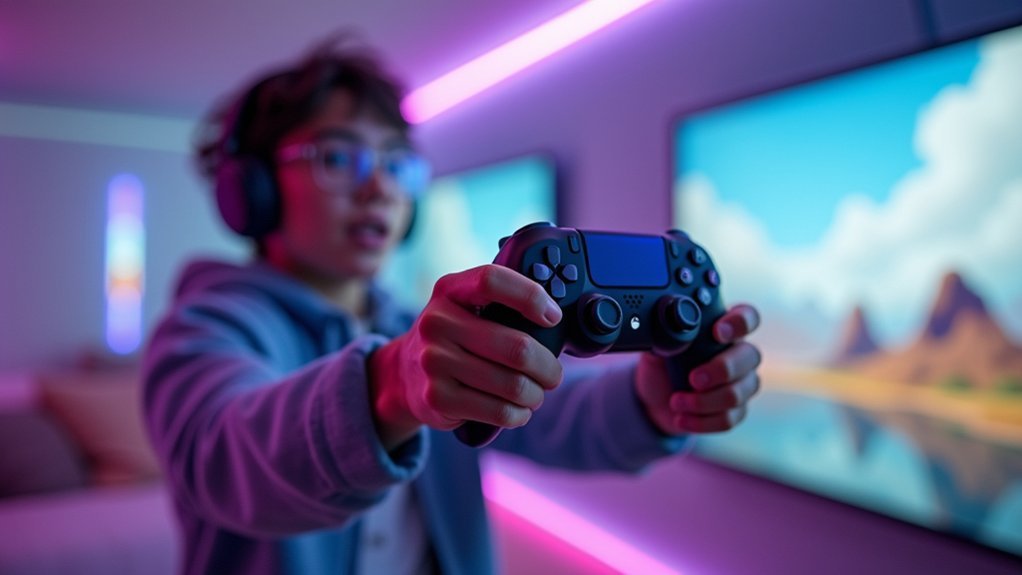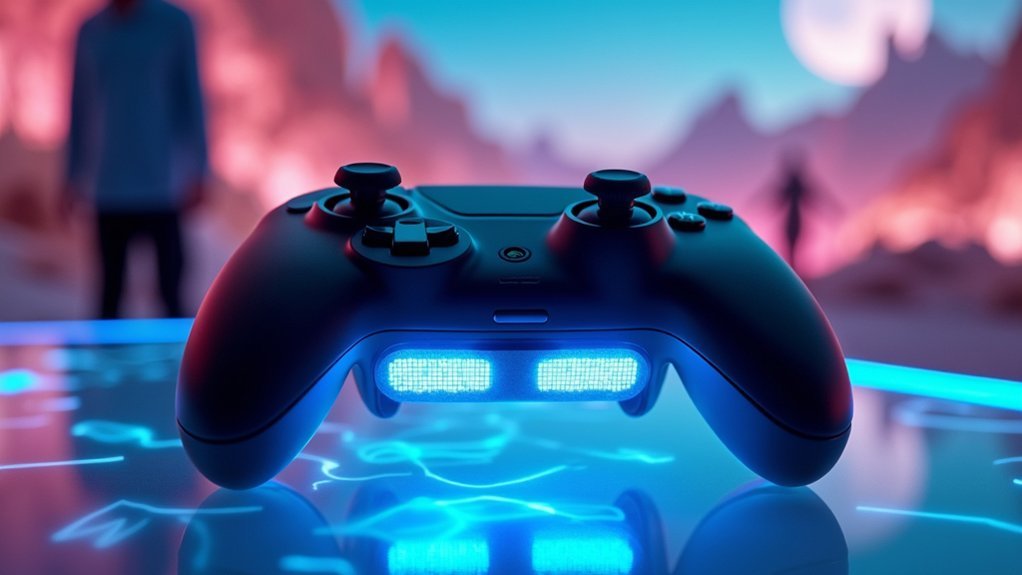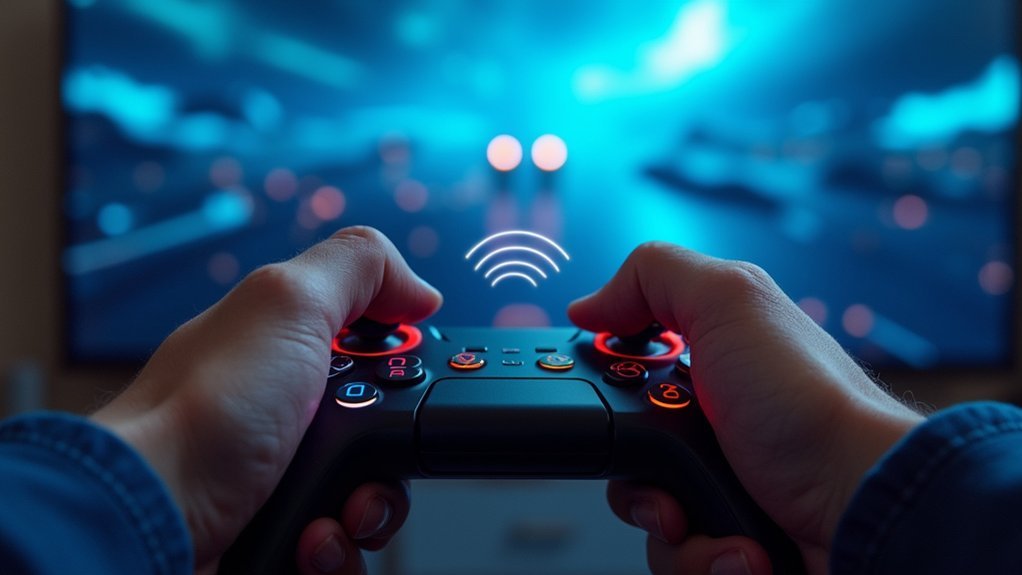Haptic feedback transforms motion gaming by converting your virtual actions into physical sensations through advanced actuators like Linear Resonant Actuators and piezoelectric systems. When you swing a sword or draw a bow, your brain’s 4 million touch receptors process realistic tactile responses that create emotional connections to gameplay. This technology eliminates lag between movement and sensation, making virtual objects feel authentically weighted and responsive. Understanding these sophisticated mechanisms reveals why this sensory integration revolutionizes gaming experiences.
How Haptic Technology Enhances Physical Sensation in Virtual Environments

Precision drives the evolution of haptic technology as it transforms virtual environments into tangible experiences.
When you engage with advanced haptics in virtual reality, you’re feeling vibrations and forces that mirror real-world interactions. You’ll experience physical sensations through sophisticated haptic actuators like Linear Resonant Actuators and voice coils that deliver precise, localized feedback.
This haptic feedback creates immersive gaming experiences that connect you directly to the virtual world. You’re not just seeing and hearing—you’re physically feeling textures, impacts, and resistance.
The user interface becomes intuitive as your hands and body receive tactile responses that make interactions realistic than ever. Advanced haptic systems simulate temperature changes and physiological responses, ensuring you’re emotionally and physically connected to every virtual moment.
The Science Behind Touch-Based Feedback in Motion Gaming Systems
When you interact with haptic feedback systems, your brain processes touch sensations through specialized neural pathways that interpret vibrations, pressure, and texture from the gaming environment.
You’ll encounter different actuator technologies working behind the scenes, including Linear Resonant Actuators that create precise vibrations and piezoelectric actuators that generate targeted pressure points.
Your nervous system transforms these mechanical signals into meaningful sensory experiences that make virtual objects feel tangible and real.
Neural Touch Processing
Although you mightn’t consciously think about it during intense gaming sessions, your brain’s constantly processing millions of neural signals that make haptic feedback so effective in motion gaming systems. Your body’s approximately 4 million touch receptors work overtime, detecting pressure, texture, and vibration from haptic actuators to create realistic feedback.
Your somatosensory cortex interprets these sensations, determining their intensity and quality to deliver an immersive experience.
When motion gaming systems trigger your neural touch processing pathways, they’re simulating real-world impacts and interactions within virtual environments. This sophisticated integration taps into your brain’s natural ability to recognize and respond to touch, creating powerful emotional connections that transform ordinary gameplay into extraordinary experiences that feel genuinely authentic.
Actuator Technology Types
The technology that powers these neural responses lies in the actuators themselves—specialized devices that transform electrical signals into the physical sensations you feel during gameplay.
Eccentric Rotating Mass actuators, common in smartphones and controllers, create vibrations through off-center spinning weights.
Linear Resonant Actuators deliver more precise feedback using spring-mounted masses, perfect for nuanced motion gaming experiences.
Piezoelectric actuators respond rapidly to electric fields, generating high-frequency sensations that make games truly immersive.
Electroactive Polymers represent cutting-edge haptic feedback technology, flexibly changing shape to simulate complex textures and forces.
These feedback systems work together in modern gaming controllers, creating everything from subtle tremors to dynamic tactile experiences that completely transform how you interact with virtual worlds.
Revolutionary Actuator Technologies Powering Modern VR Experiences

As you slip on a VR headset and reach for a virtual object, revolutionary actuator technologies work behind the scenes to make that digital touch feel startlingly real. Linear Resonant Actuators and voice coil actuators deliver precise, localized haptic feedback that transforms your VR experiences into something truly immersive and realistic.
| Actuator Type | Response Speed | Application |
|---|---|---|
| Piezoelectric | Ultra-fast | Complex textures |
| Voice Coil | Precise | Localized feedback |
| Electroactive Polymers | Adaptive | Flexible interfaces |
Advanced haptic systems in VR gloves and suits use multiple actuators simultaneously, creating full-body sensations that mirror real-world sensations. Companies like bHaptics combine electromagnetic and kinesthetic technologies to develop multi-sensory solutions. This haptic technology doesn’t just enhance gaming—it revolutionizes how you perceive virtual worlds.
Real-Time Tactile Response Integration With Movement Tracking
You’ll experience gaming’s most immersive moments when motion synchronization technology seamlessly connects your physical movements to haptic feedback systems.
Your tactile sensations achieve remarkable precision through advanced algorithms that interpret movement data and instantly translate it into corresponding vibrations, forces, and textures.
Real-time response systems eliminate lag between your actions and haptic output, ensuring you feel every impact, texture change, and environmental interaction the moment they occur in the virtual world.
Motion Synchronization Technology
When motion synchronization technology merges real-time movement tracking with haptic feedback, it creates an unprecedented level of immersive experience that transforms how you interact with virtual environments.
You’ll feel precise vibrations through Linear Resonant Actuators that generate physical sensations corresponding to your movements and in-game events. This technology lets you experience the weight and resistance of virtual objects, making interactions incredibly realistic.
In virtual reality systems, motion synchronization technology becomes essential for creating presence and physicality.
You’ll feel impacts, environmental changes, and object manipulation through tactile responses that sync perfectly with your actions. This real-time integration enhances emotional engagement by reinforcing the connection between your movements and the virtual world, making every interaction feel authentic and meaningful.
Tactile Sensation Precision
Modern tactile sensation precision relies on sophisticated actuator systems that deliver nuanced feedback matching your exact movements within milliseconds. Linear Resonant Actuators and voice coils create immersive tactile sensations that directly correlate with your player movements, transforming your gaming experience through real-time integration.
| Technology | Precision Features |
|---|---|
| PlayStation 5 DualSense | Adaptive triggers with differentiated sensations |
| HaptX Systems | Full-body VR feedback integration |
| Teslasuit Technology | Complete tactile environment simulation |
| Voice Coil Motors | Precise movement-to-feedback correlation |
Advanced systems like PlayStation 5’s adaptive triggers demonstrate how haptic feedback precision enhances immersion by letting you feel distinct in-game actions. Technologies such as HaptX push boundaries further, providing full-body VR experiences where you’ll experience varied sensations from walking on different surfaces to feeling object weight, creating truly dynamic gaming interactions.
Real-Time Response Systems
Precision tactile feedback means nothing without instantaneous response timing that matches your every move. Real-time response systems create seamless interaction loops where haptic feedback synchronizes perfectly with your actions.
Linear Resonant Actuators and voice coils deliver precise vibrations that react instantly to your movements, making immersive gaming experiences truly believable.
Motion tracking technology guarantees your controller responds the moment you act, not milliseconds later. High-fidelity haptic devices simulate textures and resistance based on your movement dynamics, creating tactile cues that enhance your situational awareness.
This integration transforms gameplay performance by providing immediate feedback that helps you react faster and more accurately. You’ll feel impacts, textures, and interactions exactly when they happen on-screen, creating an unbreakable connection between your physical actions and virtual experiences.
Force Feedback Mechanisms That Simulate Physical Resistance and Weight
Although traditional gaming controllers provided basic vibration through simple motors, today’s force feedback mechanisms employ sophisticated actuators like Linear Resonant Actuators (LRAs) and voice coils to create genuine physical resistance and weight simulation.
These gaming controllers establish a tactile connection between you and virtual environments, letting you feel gun recoil or vehicle steering resistance. Haptic steering wheels replicate road conditions, allowing you to experience tire grip across different surfaces during racing simulations.
Advanced haptic systems in VR take this further, incorporating thermal simulation and pulse sensors that respond to your actions. When you lift heavy weapons or push doors open, the force feedback creates an immersive experience that transforms how you interact with games, making virtual objects feel authentically weighted and responsive.
Advanced Vibration Motors Creating Immersive Environmental Textures

Environmental textures come alive through advanced vibration motors that translate virtual surfaces into tangible sensations beneath your fingertips.
These sophisticated systems use Linear Resonant Actuators and cutting-edge technologies to deliver precise, localized haptic feedback that transforms how you experience virtual environments.
Here’s how advanced vibration motors create immersive environmental textures:
- Surface differentiation – You’ll feel distinct vibration patterns when walking across grass versus concrete, each tailored to match real-world textures.
- Electrostatic simulation – Touchscreen surfaces replicate various materials through ultrasonic haptic technologies that mimic actual surface properties.
- Localized precision – Advanced vibration motors pinpoint exact contact areas, delivering realistic feedback that enhances your sense of presence.
- Multi-layered sensations – Combined movements and rapid vibrations create complex texture profiles that make virtual interactions feel authentically physical.
Frequently Asked Questions
Is Haptic Feedback Good for Gaming?
Yes, haptic feedback’s excellent for gaming. You’ll feel more immersed when experiencing gun recoil, environmental effects, and textures. It’ll improve your performance, precision, and emotional connection while making virtual worlds feel incredibly realistic and engaging.
What Are the Disadvantages of Haptic Feedback?
You’ll face high costs for quality devices, experience potential latency disrupting gameplay, deal with ergonomic discomfort during extended use, encounter unrealistic tactile sensations, and possibly find the feedback distracting rather than helpful.
Why Does Haptic Feedback Feel so Good?
Haptic feedback feels amazing because you’re experiencing genuine physical sensations that match what’s happening on-screen. Your brain interprets these tactile cues as real, creating deeper emotional connections and making virtual experiences feel incredibly satisfying and rewarding.
Is Haptic Feedback Just Vibration?
No, you’re experiencing much more than vibration. Haptic feedback creates precise forces, textures, and motions through advanced actuators. You’ll feel realistic sensations like resistance, impacts, and surface textures that simple vibration can’t replicate.





Leave a Reply